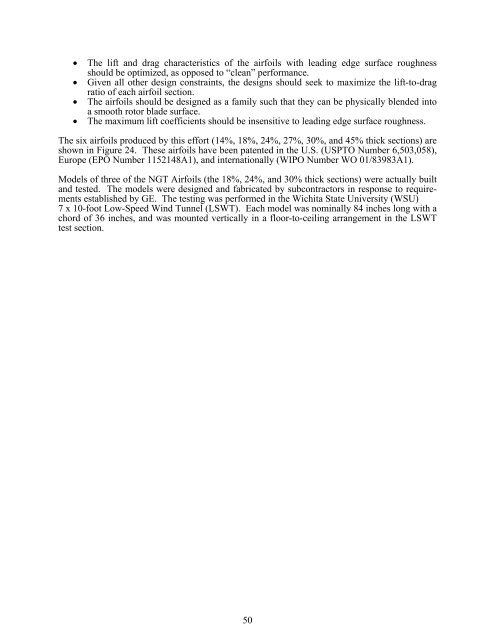Advanced Wind Turbine Program Next Generation Turbine ... - NREL
Advanced Wind Turbine Program Next Generation Turbine ... - NREL
Advanced Wind Turbine Program Next Generation Turbine ... - NREL
Create successful ePaper yourself
Turn your PDF publications into a flip-book with our unique Google optimized e-Paper software.
• The lift and drag characteristics of the airfoils with leading edge surface roughness<br />
should be optimized, as opposed to “clean” performance.<br />
• Given all other design constraints, the designs should seek to maximize the lift-to-drag<br />
ratio of each airfoil section.<br />
• The airfoils should be designed as a family such that they can be physically blended into<br />
a smooth rotor blade surface.<br />
• The maximum lift coefficients should be insensitive to leading edge surface roughness.<br />
The six airfoils produced by this effort (14%, 18%, 24%, 27%, 30%, and 45% thick sections) are<br />
shown in Figure 24. These airfoils have been patented in the U.S. (USPTO Number 6,503,058),<br />
Europe (EPO Number 1152148A1), and internationally (WIPO Number WO 01/83983A1).<br />
Models of three of the NGT Airfoils (the 18%, 24%, and 30% thick sections) were actually built<br />
and tested. The models were designed and fabricated by subcontractors in response to requirements<br />
established by GE. The testing was performed in the Wichita State University (WSU)<br />
7 x 10-foot Low-Speed <strong>Wind</strong> Tunnel (LSWT). Each model was nominally 84 inches long with a<br />
chord of 36 inches, and was mounted vertically in a floor-to-ceiling arrangement in the LSWT<br />
test section.<br />
50
















